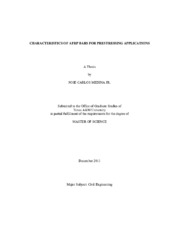| dc.description.abstract | Aramid fiber reinforced polymer (AFRP) composite materials show promise for prestressed concrete bridge applications. However, there are still some knowledge gaps due to lack of sufficient data to assess the long-term performance and therefore sustainability of beams prestressed with AFRP composite materials. The objective of this research is to effectively characterize the material properties based on the short-term and long-term characteristics of AFRP bars. Tensile, creep-rupture, and relaxation tests are experimentally conducted using AFRP bars to validate testing procedures and expand an existing limited database. Previous results from tensile tests show that the stress-strain behavior of Arapree® AFRP bars is linear until failure with tensile strength of approximately 210 ksi (1448 MPa) and strain of 2.1%. For the creep-rupture tests, three specimens are tested and monitored at four different load levels (50, 60, 75 and 85% of maximum tensile strength) throughout a period of 14 days (short-term evaluation) and 42 days (long-term evaluation). From these tests, it is expected that for a 100-year life span, 55% of the ultimate load, Fu, must be applied as an initial stress to obtain a long-term residual strength of 0.80 Fu. For the relaxation tests, six specimens at four different strain levels (50, 60, 75 and 85% of maximum tensile strain) are tested and monitored throughout a period of 14 days and 42 days. Relaxation loss profiles of the AFRP bars are developed based on the experimental data collected from prestressed AFRP bars, which have been less well understood given lack of sufficient experimental data. Overall, the results of this study provide more insight as to the reliability and potential long-term performance of AFRP bars embedded within prestressed bridge structures. | en |


